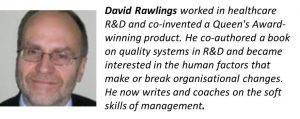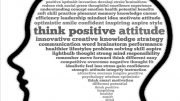Change management specialist Dave Rawlings poses the question. Have you lost the ability to try new ingredients and different methods?
In his book The Greatest Show on Earth, Richard Dawkins explains in layman’s terms how the genetic code actually gets translated into a living organism. He points out that DNA isn’t a “blueprint” in the sense of a complete description of the full-grown body of the human, the cow or the pigeon. Rather it determines the sequence of events that occur in the development of an embryo. And that sequence has many steps so it can lead to a very complex result, even though each step obeys “local rules”.
Dawkins likens this to a “recipe” rather than a “blueprint”. By analogy, each step in the recipe for making a cake is relatively simple, involves a small number of ingredients and only makes sense in relation to where you are in the process – you can’t beat the mixture after you’ve baked it! Also, if you’d never seen a cake, you wouldn’t have a good idea of the finished article just from reading the recipe unlike a blueprint or design. Similarly, DNA is the recipe for making a living organism and it’s impossible to know exactly what it will make without carrying out the process.
And this way of looking at embryos (or cakes) explains how a small error can have significant consequences.
So what has all this to do with management and personal development?
Well, I was reminded of it when thinking about individual “change” and particularly about the extent to which you can plan your life, or rather the extent to which you can actually carry out a life plan. The recipe analogy seems appropriate in that the result isn’t guaranteed because you can’t control every aspect of materials and process perfectly. So, in planning your life, you’re not really designing the finished product, rather throwing things into the pot and stirring!
And while it’s often said that if you keep doing the same things you’re likely to get the same results, it’s also true that in seeking to redirect your life, small changes can have large consequences. If so, then what you have to do to make a difference may not be as big a thing as you perhaps thought.
But have you lost the ability to try new ingredients and different methods?
Some people approach life as an experiment – always trying new things, just to see what happens. Many, perhaps most, are much more risk-averse and want to know exactly how things will work out before they press the start button. But that certainty is usually unattainable because they can’t control every detail of what happens. So life is actually a kind of experiment, and how you experience it depends on whether you’re trying to control it or looking for change.
If things are so uncertain, what then is the point of having goals or a vision? Well, I’d say that it’s really about motivation. You need something to aim at, something to draw you, to inspire you, otherwise you’ll sit back and let things happen. And what that means in practice is that you make yourself available to help fulfil somebody else’s dream!
But there is a problem with setting inspiring goals. They can seem so daunting, viewed in their entirety from the beginning, that you can’t imagine ever getting there. But really all you need at any moment is the next step in the recipe.
So, the ideal programme for life planning would have a simple structure and break down easily into bite-sized chunks. It would define the end point – whatever it is you want out of life – and also map out the whole path before putting the emphasis on tackling each step, one at a time. And providing the tools and techniques required for that step.
Perhaps you already have your end-point in mind but don’t yet have a detailed plan. Then why not just break the first egg anyway?
 Email: david@changeworkcoaching.com
Email: david@changeworkcoaching.com




